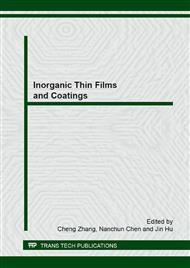p.234
p.238
p.243
p.247
p.252
p.256
p.261
p.265
p.269
Preparation and Performance Characterization of Nanometer-Sized Tourmaline (Schorl) Films
Abstract:
Tourmaline has characteristics of repeatedly producing electric dipole polarity transformation. Using FTO glass substrate coated with conductive films as raw materials, the research aims to prepare functional glass materials, which have spontaneous polarization effect, absorption of wideband electromagnetic radiation and high visible light transmittance. This paper applied Magnetron Sputtering deposition technique, studying on tourmaline as target, sputtering on conductive FTO glass, using multiple means to measure and analyze the surface morphology, component, structure, electrical and magnetic properties. And the functions of tourmaline as composite electromagnetic shielding films are also discussed in the paper.
Info:
Periodical:
Pages:
252-255
Citation:
Online since:
January 2013
Authors:
Keywords:
Price:
Сopyright:
© 2013 Trans Tech Publications Ltd. All Rights Reserved
Share:
Citation:


